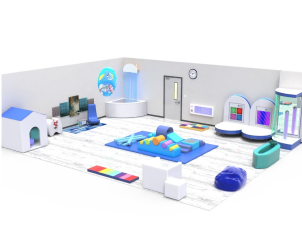For a parent of a child with autism or a sensory processing disorder, visiting a library with your child could feel like a nightmare, or even an impossibility. Fluorescent lighting, an overwhelming amount of book choices and the expectation to use an indoor voice at all times can be overwhelming for a child. When a child has a sensory meltdown in the center of an otherwise pindrop silent library that can be very stressful for a parent.
What if there was a way to make the library more accessible?
What if there was a way to bridge the needs of this population and the expectations of the library setting so that more kids could access the incredible world of literature and expand their knowledge and imagination? Libraries across the country are on a quest to do just that. By creating sensory rooms within their spaces, libraries are carving out space for kids to take a sensory break when needed.
In a library sensory room, you can expect to find approachable, kid-friendly play materials that kids can see, touch and explore to regulate their bodies through calming sensory experiences. Cozy seating, bubble tubes, gel tiles and weighted blankets are just some of the sensory elements a library sensory room may offer. In many, families can reserve the space in advance and receive an orientation tour from library staff. Library sensory rooms can serve a broad population. In addition to those with autism or sensory processing disorder, individuals with dementia or recovering from strokes or traumatic brain injuries benefit as well. Many sensory rooms are also designed specifically to create a family experience, with equipment that appeals to all.
Some libraries, such as the Louisville (Ohio) Public Library, offer two distinct areas within the sensory room, with each area carefully designed to meet a different need. One area may be geared toward an alerting experience, increasing engagement with the environment. Another area may serve as a calming ‘chill zone’ when a sensory break is needed. This approach recognizes that there are different kinds of sensory needs. A child’s sensory system can often be described as over-responsive or under-responsive. In both cases, an optimal arousal level feels far from reach and the child needs help regulating their emotions to reach that level. A over-responsive child may need calming input, such as dim lighting, soft weighted blankets and noise cancelling headphones to lower their arousal level when they’ve approached sensory overload. An under-responsive child could benefit from bright lights and exposure to various textures and movement to increase their level of alertness and meaningful engagement with the world around them. As libraries continue to install sensory rooms, these are all factors to consider.
Each library sensory room offers something unique to its visitors. There are even libraries that offer sensory gardens! Response to library sensory rooms has been very positive, with high turnout from appreciative patrons. Within one week of opening, the Sensory Space at the Louisville (Ohio) Public Library received 1,000 visitors. This has prompted more and more libraries to consider how they can create their own sensory space. Many are researching grant opportunities to help fund the endeavor. With this innovation being relatively new, libraries are also eager to hear feedback from those who have used the space.
Connect with our team to start designing your sensory room today. Our Sensory Room Design Team would love to work with you and your space to increase inclusion in libraries everywhere!



















Comments